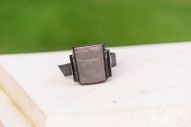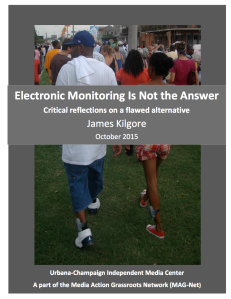
In August I travelled to California as part of my research into the use of electronic monitoring in the criminal justice system. My first stop was a converted factory along the border between South Central Los Angeles and Inglewood, Chuco’s Justice House. Chuco’s houses a variety of social justice projects. The name honors Jesse “Chuco” Becerra, a community activist killed in the streets of this neighborhood in 2003.
The Shackle of a “Chattel Slave”
My investigations began with Ernest Shepard, who spent 45 years locked up in California state prisons. Paroled in 2011, “Ern” had three months on a monitor. As an African American man, he said the black plastic band looked like a shackle and made him feel “like a chattel slave.” He felt a constant urge to remove it-as a test of his own integrity. “If I don’t rebel,” he used to think to himself, “what kinda dude am I?”
Fortunately Ern was surrounded by people from Fair Chance, a reentry project based at Chuco’s. He said the people at Fair Chance kept him focused on the “bigger picture.” Today Ern sits a month from completing parole, devoting his life to helping others who are coming home from prison.
From Ern, I moved to the larger canvas of the Youth Justice Coalition (YJC). Founded in the early 2000s, YJC’s mission is to “build a youth, family and prisoner-led movement to challenge race, gender and class inequality in the Los Angeles County and California juvenile injustice system.” YJC runs Free LA High School which provides academic education as well as training in social justice organizing. Through a collective process, YJC helps shape a new world for African American and Latino/a youth who have been cast into the school to prison pipeline by mainstream America. The YJC banner across the main conference room at Chuco’s reads, “college prep, not prison prep.” YJC members are high profile participants in campaigns against the LA No More Jails. They also push their 1% project―a proposal to reallocate 1% of the county law enforcement budget to youth programs.
I did a group interview, sitting around a table with eight youth and Whitney Richards-Calathes, a Ph.D. student and YJC Board member. As the only white person and the only one over thirty in the room, I thought carefully about how to break the ice. Bags of Cheetos and bottles of sweetened tea in the center of the room helped, as well as my own experience of incarceration and being on a monitor. In any case, the youth quickly opened up.
Special Room in a High School to Charge Monitors
Electronic monitoring was familiar territory here, part of the punishment package the system has visited upon young people of color. Twenty-one year old Jerry Bates told me he had been to one high school which had a special room for students on ankle bracelets to charge their monitors. Most ankle bracelets need to be plugged into a wall socket twice a day or they lose signal, possibly prompting an alarm or even an arrest.
Nineteen year old Tanisha Denard helped focus the discussion. Placed on a monitor as a result of a petty theft case, she found the device “terrifying” initially. She didn’t understand how it worked or what it could do. Her fear turned to frustration under the house arrest regime that accompanied the bracelet. “I wouldn’t say I’d rather be in jail (but) you might as well be in jail. You all take house arrest but then when you are at home for a couple days, it’s just like you’re in jail. Even if you’re the kind of person who never goes out, you start feeling it.”
“They give you the worst options, a strike or take this deal (the monitor),” another youth added. Jerry described the bracelet as “a way of keeping you locked up without having to lock you up” as well as a way “to make money off of you.”
“It Decreases You”
Christian Salazar perhaps best summed up the group sentiment toward the monitor in a single word “stressful.” He said “It decreases you…your personality… It takes a whole lifetime to build a character and it only takes one second to shatter it and everybody looks at you and says he really was a bad kid.” At age 17 he chose the bracelet over eight months in a juvenile boot camp.
While some people complained about the discomfort of the device or not being able to wear it in the shower, the key issue remained the stress highlighted by Salazar. Michelle Watson recalled how a friend of hers went “crazy” with the monitor, “crying for days. I spent four days at her house.” Michelle described how her friend kept “clawing at this thing” and “banging her leg against the wall.” She apparently thought people could watch her through the box on the bracelet.
Michelle also felt that the bracelet was demeaning. “I watch Animal Planet a lot,” she said, “When they catch these wild animals they shoot a tag through their ear and then they let them go. That’s how they do you guys. They put a tracker on you and then they let you go. That’s dehumanizing…and then you guys got to pay. That’s insane.”
Several people developed their own ways of pushing back. For example, one of the youth who preferred to remain anonymous was charged $160 to initialize the ankle bracelet service. She said she told authorities she was homeless to avoid the daily fees which come with many monitoring regimes.
Tanisha started going to church, even though she had no religious inclinations. It was the only way she could get out of the house on weekends. She had to hand over the agenda from the service to the probation officer to prove she actually attended. Others told how friends on the monitor would test the technology by dashing off to the store to buy a pack of cigarettes and see if it triggered an alarm. The technology is designed to send a message to authorities if the person being monitored leaves the house at a time where they have not been granted permission.
The Future: Everyone on GPS?
Probing the future of such technology raised serious concerns. Christian simply raised his smart phone and said, “we already got this.” Jerry argued that they were just “testing now” and would eventually have “everyone on GPS.” Michelle agreed but added a twist, “in the future tracking will be expanded to everybody…except if you got enough money to avoid it.”
Ultimately, my conversations at Chuco’s proved both frustrating and inspiring. Ern’s image of the slave shackle wouldn’t go away. Further frustration came with discovering yet another way in which the injustice of mass incarceration and its technological tentacles reinforces race and class inequality. White students in the more comfortable parts of Los Angeles (or our local University of Illinois pupils) generally don’t have to think about having monitors on their ankle, let alone the prospect of a trip inside the Department of Corrections. Yet YJC members are already experts. Despite their situation, the presence of an organization like the YJC demonstrates that an alternative is possible―an alternative where the voice of the poor and oppressed speaks loud and lights up the sky with great ideas. If YJC could actually get that 1% of the county’s law enforcement budget (1%=about $100 million according to YJC), the world for youth in their community would become a very different place and likely one without any rooms in high schools where students would go to charge their ankle bracelets.

 In recent months, authorities in at least two countries, Germany and Israel, have suggested putting electronic monitors on people with ties to or a history of involvement with “terrorist” groups. While at the moment this is targeted at a narrow circle of people, this effectively opens the door to discussion of monitoring a range of people viewed as “political dissidents,” “subversives”, “revolutionaries”, “militants,” etc. In the light of the recent upsurges in political activity in the US, especially the mobilizations among people of color around issues of police violence and immigrant rights, there is cause for concern.
In recent months, authorities in at least two countries, Germany and Israel, have suggested putting electronic monitors on people with ties to or a history of involvement with “terrorist” groups. While at the moment this is targeted at a narrow circle of people, this effectively opens the door to discussion of monitoring a range of people viewed as “political dissidents,” “subversives”, “revolutionaries”, “militants,” etc. In the light of the recent upsurges in political activity in the US, especially the mobilizations among people of color around issues of police violence and immigrant rights, there is cause for concern.






